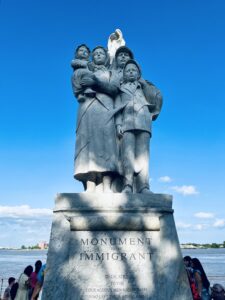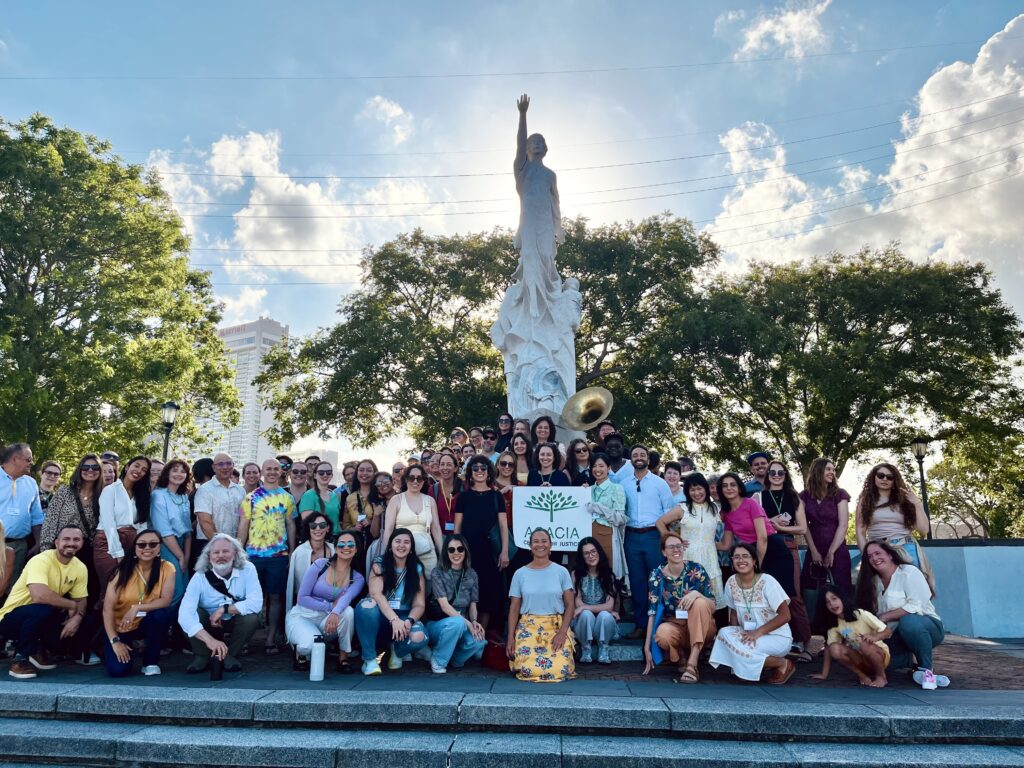In May, the Acacia Center for Justice hosted an in-person training in New Orleans for legal services providers to more effectively advocate for people in immigration detention. On the second day of the convening, we celebrated the important work of our partners, New Orleans-style, with a second line.
As the Communications Associate for Acacia, I had the opportunity to return to my hometown to document the training and second line. I was born and raised in New Orleans, and growing up I would often hear second lines passing outside of my house.
A second line has two parts. The grand marshal, or parade leader, the brass band, and the person being celebrated all take the front; this is the main line. The participants who follow behind the brass band, dancing and strutting, make up the second line. Typically, second lines honor major life events, from weddings and graduations to funerals. Even in mourning, we never miss an opportunity for live music in New Orleans.
A second line is a celebration of life, but it is also rooted in Black resistance and liberation. The musical traditions behind second lines and Jazz can be traced back to West Africa, where music is a vital part of mourning traditions.
By the early 1800s, New Orleans was the center of the U.S. slave trade. Enslaved peoples were only allowed one day a week to rest, which they celebrated with music, dance, and trade. They were only allowed to gather in Congo Square, just a few blocks from the site of our training. When slavery in Louisiana ended in 1864, Black community organizers gathered thousands of people in Congo Square to celebrate with a musical parade, in what may have been one of the nation’s first Juneteenth celebrations.
Following Emancipation, Black mutual aid societies flourished in New Orleans as free people left plantations for the city. They organized social events, such as jazz funerals, to support their members and build community. However, in the aftermath of Reconstruction, anti-Black politicians across the South began to strip away Black Americans’ civil rights and institute segregation. Over the next few decades, these musical street events became a way to visibly take up space in a city that criminalized Black people simply for existing. Eventually, these jazz funerals and parades became commonly referred to as the second line.
Today, second lines are a quintessential part of celebrations and festivals in the city. Many are still organized by social aid and pleasure clubs, who continue to operate in the same spirit of community and mutual aid. When activists succeeded in officially removing the city’s statue of Robert E Lee, over a thousand people joined a “second line to bury white supremacy,” beginning at Congo Square.
Our second line in May was another celebration, one that honored immigrants as the fabric of our community. Our main line was led by Soul Brass Band, a New Orleans brass band founded and led by Derrick Freeman, an acclaimed percussionist. A band of all-star New Orleans musicians joined him: James Martin, Mark Levron, Miles Lyons, and Kyle Sharamitaro.
Even in the Louisiana heat, our partners were exuberant. As the brass band struck jazz classics, a group of over a hundred immigration lawyers and advocates took to Canal Street, waving our arms in the air and strutting along to the beat. 
Our final stop was the Monument to the Immigrant, commissioned by Italian Americans. A marble muse, symbolizing hope, holds a star above the Mississippi river; on the other side of the monument, a family of immigrants faces the city, taking in their new home.
As I looked at the weary family, I couldn’t help but be reminded of all of the challenges of our movement. Just as Italian Americans faced significant discrimination and barriers to settling in the U.S —one of the worst incidents taking place in New Orleans— anti-immigrant policies and narratives threaten the wellbeing of all of our communities.
In spite of the challenges, our partner immigration lawyers and advocates continue to defend and deliver justice to vulnerable people in immigration detention. As we all gathered around the statue for a group photo, the air was filled with laughter, joy in our resistance to oppressive systems, and the lingering energy of jazz.
